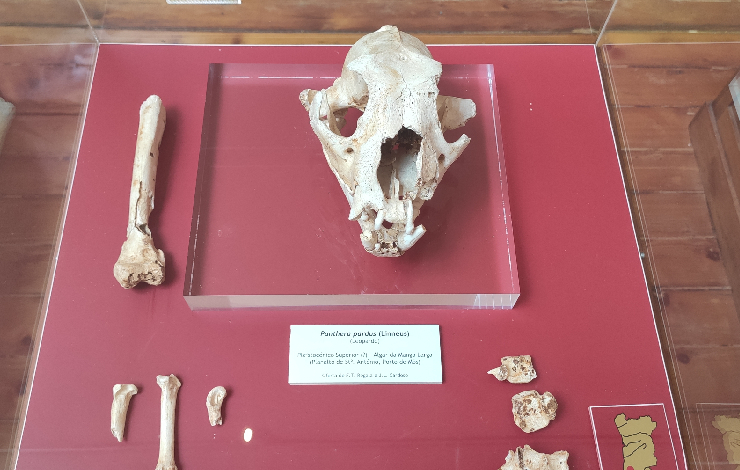16-01-2025

Photo: Skeleton of the "Leopard from Algar da Manga Larga," Geological Museum
An international team of scientists, including researchers from the NOVA School of Science and Technology | NOVA FCT, has published findings in Science Advances on the evolution and adaptations of the snow leopard lineage during the last Ice Age.
During the coldest phases of the last Ice Age, snow leopards expanded beyond the Himalayas to Central China and, in a surprising twist, westward to the Iberian Peninsula. Here, researchers studied a remarkable fossil: a partial leopard skeleton, including an almost perfectly preserved skull, known as the "Leopard from Algar da Manga Larga." Discovered in Porto de Mós (Portugal) in the early 2000s, this fossil belongs to the snow leopard lineage in Western Europe.
This discovery has significant implications for snow leopard conservation, a critically endangered species. The study argues that snow leopards prioritize steep, rocky terrains and cold climates, not necessarily requiring high altitudes, challenging long-held assumptions about their habitat preferences.
The research highlights the unique traits distinguishing snow leopards from their more common relatives. While common leopards evolved to hunt agile prey in partially forested habitats, snow leopards developed distinct features for dominating mountainous landscapes. These include larger molars, domed skulls, and stronger jaws and limbs—ideal for taking down robust prey like mountain goats.
Their survival in rocky, barren terrains also depended on other critical adaptations: enhanced binocular vision, a large ectotympanic cranial structure for better hearing, powerful limbs to endure the impact of jumping between rocks, and a long tail for balance. All these traits evolved rapidly during the Quaternary period, particularly from the Middle Pleistocene onwards.
Future investigations will delve into the neuroanatomy and paleoecology of this Portuguese specimen, dubbed "the Leopard from Algar da Manga Larga."
“It was truly a remarkable surprise to find a member of this feline lineage in Pleistocene Portugal. This underscores the importance of revisiting materials stored in museums, as well as the value of international collaboration—this discovery was only possible thanks to extensive contextualization with other materials from China,” explained Darío Estraviz-López, a PhD candidate in Geology at NOVA FCT.
Full article available here: https://www.science.org/doi/10.1126/sciadv.adp5243
In the Press
Fóssil de leopardo-das-neves descoberto em Portugal desvenda mistérios da espécie, SIC Notícias
Fóssil de leopardo-das-neves descoberto em Portugal desvenda mistérios da espécie, RTP
Fóssil de leopardo-das-neves descoberto em Portugal desvenda mistérios da espécie, dnotícias.pt
Fóssil de leopardo-das-neves descoberto em Portugal desvenda mistérios da espécie, Terras do Homem
Fóssil de leopardo-das-neves descoberto em Portugal desvenda mistérios da espécie, Correio da Manhã
Fóssil de leopardo-das-neves descoberto em Portugal desvenda mistérios da espécie, Diário de Aveiro
Fóssil de leopardo-das-neves descoberto em Portugal desvenda mistérios da espécie, Diário de Leiria
Fóssil de leopardo-das-neves descoberto em Portugal desvenda mistérios da espécie, Impala
Fóssil de leopardo-das-neves descoberto desvenda mistérios da espécie, Notícias ao Minuto
Fóssil de leopardo-das-neves descoberto em Portugal desvenda mistérios da espécie, Sapo